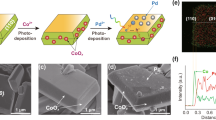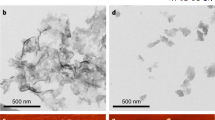Abstract
Natural photosynthesis, which achieves efficient solar energy conversion through the combined actions of many types of molecules ingeniously arranged in a nanospace, highlights the importance of a technique for site-selective coupling of different materials to realize artificial high-efficiency devices1. In view of increasingly serious energy and environmental problems, semiconductor-based artificial photosynthetic systems consisting of isolated photochemical system 1 (PS1), PS2 and the electron-transfer system have recently been developed2,3. However, the direct coupling of the components is crucial for retarding back reactions to increase the reaction efficiency. Here, we report a simple technique for forming an anisotropic CdS–Au–TiO2 nanojunction, in which PS1(CdS), PS2(TiO2) and the electron-transfer system (Au) are spatially fixed. This three-component system exhibits a high photocatalytic activity, far exceeding those of the single- and two-component systems, as a result of vectorial electron transfer driven by the two-step excitation of TiO2 and CdS.
This is a preview of subscription content, access via your institution
Access options
Subscribe to this journal
Receive 12 print issues and online access
$259.00 per year
only $21.58 per issue
Buy this article
- Purchase on Springer Link
- Instant access to full article PDF
Prices may be subject to local taxes which are calculated during checkout




Similar content being viewed by others
References
Mokari, T., Rothenberg, E., Popov, I., Costi, R. & Banin, U. Selective growth of metal tips onto semiconductor quantum rods and tetrapods. Science 304, 1787–1790 (2004).
Sayama, K., Mukasa, K., Abe, R., Abe, Y. & Arakawa, H. Stoichiometric water splitting into H2 and O2 using a mixture of two different photocatalysts and an IO3−/I− shuttle redox mediator under visible light irradiation. Chem. Commun. 2416–2417 (2001).
Kato, H., Hori, M., Konta, R., Shimodaira, Y. & Kudo, A. Construction of Z-scheme type heterogeneous photocatalysis systems for water splitting into H2 and O2 under visible light irradiation. Chem. Lett. 33, 1348–1349 (2004).
Gräztel, M. Photoelectrochemical cells. Nature 414, 338–344 (2001).
Gur, I., Fromer, N. A., Geier, M. L. & Alivisatos, A. P. Air-stable all-inorganic nanocrystal solar cells processed from solution. Science 310, 462–465 (2005).
Steckel, J. S. et al. Blue luminescence from (CdS)ZnS core-shell nanocrystals. Angew. Chem. Int. Edn 43, 2154–2158 (2004).
Ohko, Y. et al. Multicolour photochromism of TiO2 films loaded with silver nanoparticles. Nature Mater. 2, 29–31 (2003).
Xu, J., Zhao, W., Luo, X. & Chen, H. A sensitive biosensor for lactate based on layer-by-layer assembling MnO2 nanoparticles and lactate oxidase on ion-sensitive field-effect transistors. Chem. Commun. 792–794 (2005).
Tsubata, S., Haruta, M., Kobayashi, T., Ueda, A. & Nakahara, Y. Preparation of Catalysts V 695–704 (Elsevier, Amsterdam, 1991).
Kiyonaga, T. et al. Ultrafast photosynthetic reduction of elemental sulfur by Au nanoparticle-loaded TiO2 . J. Phys. Chem. B 110, 10771–10778 (2006).
Honma, I., Sano, T. & Komiyama, H. Surface-enhanced Raman scattering (SERS) for semiconductor microcrystallites observed in silver-cadmium sulfide hybrid particles. J. Phys. Chem. 97, 6692–6695 (1993).
Brus, L. E. Electron-electron and electron-hole interactions in small semiconductor crystallites: The size dependence of the lowest excited electronic state. J. Chem. Phys. 80, 4403–4409 (1984).
Weller, H. Colloidal semiconductor Q-particles: Chemistry in the transition region between solid state and molecules. Angew. Chem. Int. Edn 32, 41–53 (1993).
Hattori, A. & Tada, H. High photocatalytic activity of F-doped TiO2 film on glass. J. Sol–Gel Sci. Technol. 22, 47–52 (2001).
Tada, H. et al. Au-core/Pt-shell bimetallic cluster-loaded TiO2. 1. adsorption of organosulfur compound. J. Phys. Chem. B 106, 8714–8720 (2002).
Spanhel, L., Weller, H. & Henglein, A. Photochemistry of semiconductor colloids. 22. Electron injection from illuminated CdS into attached TiO2 and ZnO particles. J. Am. Chem. Soc. 109, 6632–6635 (1987).
Hirai, T., Suzuki, K. & Komasawa, I. Preparation and photocatalytic activities of composite CdS nanoparticles-titanium dioxide particles. J. Colloid Interface Sci. 244, 262–265 (2001).
Kittel, C. Introduction to Solid State Physics 7th edn, 302 (Wiley, New York, 1996).
Nosaka, Y. Finite depth spherical well model for excited states of ultrasmall semiconductor particles: an application. J. Phys. Chem. 95, 5054–5058 (1991).
Kalyanasundaram, K., Borgarello, E. & Grätzel, M. Visible light induced water cleavage in CdS dispersions loaded with Pt and RuO2, hole scavenging by RuO2 . Helv. Chim. Acta 64, 362–366 (1981).
Tada, H., Soejima, T., Ito, S. & Kobayashi, H. Photoinduced desorption of sulfur from gold nanoparticles loaded on metal oxide surfaces. J. Am. Chem. Soc. 126, 15952–15953 (2004).
Asahi, R., Morikawa, T., Ohwaki, T., Aoki, K. & Taga, Y. Visible-light photocatalysis in nitrogen-doped titanium oxides. Science 293, 269–271 (2001).
Acknowledgements
H.T. thanks T. Kawahara for discussions throughout this work. This work was partially supported by a Grant-in-Aid for Scientific Research (C) No. 16550169 from the Ministry of Education, Science, Sport, and Culture, Japan.
Author information
Authors and Affiliations
Contributions
H.T.: project planning, data analysis. T.M. and T.K.: experimental work (electronic absorption spectra, TEM and photocatalytic reactions). T.A. and K.T.: experimental work (HRTEM and EELS).
Corresponding author
Ethics declarations
Competing interests
The authors declare no competing financial interests.
Supplementary information
Supplementary Information
Supplementary figure S1
Supplementary Information
Supplementary figure S2
Supplementary Information
Supplementary figure S3
Supplementary Information
Supplementary table S1
Rights and permissions
About this article
Cite this article
Tada, H., Mitsui, T., Kiyonaga, T. et al. All-solid-state Z-scheme in CdS–Au–TiO2 three-component nanojunction system. Nature Mater 5, 782–786 (2006). https://doi.org/10.1038/nmat1734
Received:
Accepted:
Published:
Issue Date:
DOI: https://doi.org/10.1038/nmat1734
This article is cited by
-
TiO2-based S-scheme photocatalysts for solar energy conversion and environmental remediation
Science China Materials (2024)
-
Methodologies for enriched photocatalytic CO2 reduction: an overview
International Journal of Environmental Science and Technology (2024)
-
Exploring modern developments in diverse 2D photocatalysts for water oxidation
Journal of Porous Materials (2024)
-
Synthesis of mesoporous Ag/α-Fe2O3/TiO2 heterostructures with enhanced and accelerated photo/-catalytic reduction of 4-nitrophenol
Environmental Science and Pollution Research (2023)
-
A comprehensive review on semiconductor-based photocatalysts toward the degradation of persistent pesticides
Nano Research (2023)



